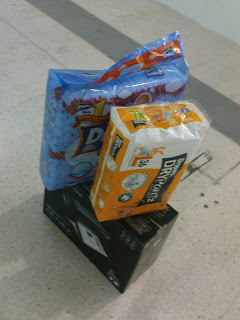Sejak Mon Ziqri dah tukar minum Isomil Advanced Eye Q. As advise by doc. Tukar susu because of eczema. Doc bgtau Ziqri maybe allergy to the cow's milk. Arini nmpk dah kurang skit merah-merah badan dia since minum Isomil Advanced Eye Q. Susu ni utk 0-12 months. Lepas tu kena tukar minum Isomil Plus Eye Q.
Memandangkan Ziqri kena minum soy milk, kena lar carik info pasal soy milk ni. Some Q&A to share about soy milk:
Q1: Will a soy-based formula support normal child growth?
SBF is adequately packed with energy, proteins, vitamins, minerals, and fibre necessary for a child’s normal growth
SBF supports :
• Normal growth and development:10,11
o SBFs are as good as cow’s milk-based formula (CMBF) in supporting growth. Children fed with SBFs enjoy normal and comparable growth to children fed with CMBF. 11,18 SBF-fed children enjoyed comparable growth rate as compared with children fed with CMBF.11 Importantly, children fed with SBF or CMBF how improvements in terms of weight gain, and length and head circumference, which are similar with either formula.11
• Normal bone mineralization:18
o Calcium absorption is essentially equivalent with SBF or CMBF.14Both SBF and CMBF produce comparable serum levels of calcium, magnesium, alkaline phosphatase and parathyroid hormone, which support bone growth. Furthermore,children fed with SBF have good bone mineral content and bone width, similar to CMBF fed children.18
• Normal immune system development.19,20
• An iron-fortified formula that is as effective as cow’s milk in preventing iron deficiency.21
Q2: Does SBF support the immune system of growing children?
SBF has a high nucleotide content (300 mg/L), as these protein building blocks are found naturally in soy. The need for nucleotides increases during a child’s growth and development, and the inclusion of dietary nucleotides in SBF ensures normal immune development as measured by antibody response to childhood immunization.
Q3: When is SBF most suitable?
SBF is a safe and cost-effective alternative feed for children with galactosemia and primary lactase deficiency.23 The American Academy of Pediatrics (AAP) has advocated that formula-fed children with lactose intolerance to cow’s milk-based formula, congenital galactosemia or strict dietary restrictions like vegetarianism should be given SBF.23 Soy products in fact have been consumed by Asian children for centuries and are commonly used to wean children with an allergy to cow’s milk protein.2 Furthermore, SBF can be used to provide relief of perceived formula intolerance such as vomiting, fussiness or colic.23 Consumption of SBF is very popular due to the widespread understanding that soy is both good and nutritious.
Q4: Can SBF be a replacement for cow’s milk based formula?
CMBF is a good source of calcium and protein; however, fortified SBF containing calcium, vitamins A and D is as good as cow’s milk in its nutritive value. SBF provides additional nutrients such as vitamins B1, B3, and fibre. SBF also provides trace minerals such as magnesium, which helps in calcium absorption, and copper and manganese, which enhance bone formation. Moreover, SBF is lactose-free, making it an attractive option for children who are lactose intolerant. SBF can help achieve a healthy diet in children who are avoiding dairy products due to health reasons, ie cow’s milk protein allergy or personal beliefs.
Q5: My child is allergy to cow’s milk protein, how long should I give him/her soy-based formula?
Cow’s milk protein allergy (CMPA) is common in young children,26and it was widely believed that most children would outgrow the allergy by the age of 3 years.27 However, a recent study suggests that the CMPA could last longer than previously reported, and some children outgrow the allergy only during adolescence.27 Based on a study conducted by researchers at the John Hopkins University, it has been demonstrated that CMPA persists into school age and well into adolescence. The study found that up to 64% of children outgrew CMPA by age 12 and 79% by age 16. Some took longer and remained allergic until age 18. 27 Allergies in children are more common today than 20 years ago, and the average age of outgrowing them is also higher. Since there is no medication or an intervention to speed up the process of outgrowing allergies, it is critical that children with CMPA receive adequate nutrition through alternative food sources such as SBF to help support their normal growth and development.
Q6: Is SBF safe for my child?
Despite the widespread use of soy products in Asia, there are concerns about the chemical make up of soy and its use in SBFs. Isoflavones in the SBFs weakly mimic the action of estrogen (a female hormone present in the human body) raising concerns among parents about the adverse effects this would have on human growth, development and reproduction. However, studies have shown that exposure to SBF does not affect general health or outcomes when compared with cow’s milk.28 Young adults who had been fed with SBF as children show similar reproductive development and pubertal maturation to those who were fed with CMBF.28 The American Academy of Pediatrics Committee on Nutrition (AAPCON 2008) has concluded that there is no conclusive evidence from animal studies or studies on children/adults that dietary isoflavones adversely affect human development, reproduction or endocrine function. Given the long history of use, acceptance of SBF feeding by the United States Food and Drug Administration (FDA) and the AAP, and several clinical studies showing an absence of adverse health effects, it is clear that SBF is safe and supports normal growth, development and reproduction.
And also some infos about the cow's milk allergy.
Cow's Milk Protein Allergy (CMPA)
Do you know that up to 7.5% of babies are allergic to cow's milk?
What is cow's milk protein allergy (CMPA)?
Cow's milk protein allergy (CMPA) is the most common food allergy in children. A milk allergy usually starts when a child is given formula and has an allergic reaction to the protein of cow's milk. Approximately 3% of children are allergic to milk. 1 A minority of them will outgrow the allergy within the first 3 years of life. Some children develop tolerance during adolescence. However, some of them will retain allergy for life.
How do I know if my child is allergic to cow's milk?
Cow's milk protein allergy shows up in a variety of forms. The signs can come on suddenly or over a period of hours to days after ingesting the milk. A child can experience one or more of these symptoms:
Type 1: Early Reaction
• Appears 45 minutes after milk ingestion
• Colic, diarrhea, vomiting, skin rash, eczema, occasionally wheezing or sneezing
Type 2: Intermediate Reaction
• Appears 45 minutes to 20 hours after milk ingestion
• Vomiting and diarrhea
Type 3: Late Reaction
• Appears after 24 hours of milk ingestion
• Diarrhea, vomiting, wheezing and coughing
These symptoms may also occur with many other illnesses, so it is always best to check with your doctor to confirm or rule out milk allergy as a possible cause.
What causes CMPA?
1. Family history of allergy
If either parent is allergic to cow's milk, your child will tend to have an increased risk of developing cow's milk protein allergy.
2. Shorter duration of exclusive breastfeeding
3. Early exposure to cow's milk
What to do if your child is allergic to cow's milk
• Cow's milk-based formulas need to be totally eliminated and substituted with an appropriate formula.
• Soy-based formulas have been used to feed children with cow's milk allergy since 1929.2
• Soy-based formulas have been used increasingly as an alternative for children with adverse reaction to cow's milk.2
• Majority of children allergic to cow's milk can tolerate soy-based formulas very well.
• Soy-based formula can provide appropriate nutrients to support growth and development.2
• Lactose-free formulas do have milk protein, so avoid them.
P/s: Other than Isomil, apa lagi brand soy milk?? Mcm tak byk choice jer...Saje nak tau. So far Ziqri ok minum Isomil tu. And rasanya we just stick to that brand jer.



























































